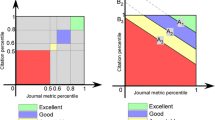Abstract
Journals have been ranked on the basis of impact factors for a long time. This is a quality indicator, and often favours review journals with few articles. Integrated impact indicators try to factor in size (quantity) as well, and are correlated with total number of citations. The total number of papers in a portfolio can be considered a zeroth order performance indicator and the total number of citations a first order performance indicator. Indicators like the h-Index and the g-Index are actually performance indicators in that they integrate both quality and quantity assessment into a single number. The p-Index is another variant of this class of performance indicators and is based on the cubic root of a second order performance indicator called the exergy indicator. The Eigenfactor score and article influence are respectively first order quantity and quality indicators. In this paper, we confirm the above relationships.
Similar content being viewed by others
References
Abbas, A. M. (2010). Analysis of generalized impact factor and indices of journals. arXiv:1011.4879, 1–7.
Abbas, A. M. (2011). Bounds and inequalities relating h-index, g-index, e-index and generalized impact factor. arXiv:1103.5045v1.
Althouse, B. M., West, J. D., Bergstrom, C. T., & Bergstrom, T. (2008). Differences in impact factor across fields and over time. Journal of the American Society for Information Science and Technology, 60(1), 27–34.
Bergstrom, C. T. (2007). Eigenfactor: Measuring the value and prestige of scholarly journals. College & Research Libraries News, 68(5), 314–316.
Bergstrom, C. T., West, J. D., & Wiseman, M. A. (2008). The Eigenfactor metrics. Journal of Neuroscience, 28(45), 11433–11434.
Chen, C. (2006). CiteSpace II: Detecting and visualizing emerging trends and transient patterns in scientific literature. Journal of the American Society for Information Science and Technology, 57(3), 359–377.
Egghe, L. (2006a). An improvement of the h-index: The g-index. ISSI Newsletter, 2(1), 8–9.
Egghe, L. (2006b). Theory and practice of the g-index. Scientometrics, 69(1), 131–152.
Garfield, E. (1955). Citation indexes to science: A new dimension in documentation through association of ideas. Science, 122(3159), 108–111.
Garfield, E. (1999). Journal impact factor: A brief review. Canadian Medical Association Journal, 161(8), 979–980.
Garfield, E. (2005). The agony and the ecstasy: The history and meaning of the journal impact factor. international congress on peer review and biomedical publication. http://garfield.library.upenn.edu/papers/jifchicago2005.pdf.
Hirsch, J. E. (2005). An index to quantify an individual’s research output. Proceedings of National Academy of Sciences (PNAS), 102(46), 16569–16572.
Leydesdorff, L., & Bornmann, L. (2011). Integrated impact indicators (I3) compared with impact factors (IFs): An alternative design with policy implications. Journal of the American Society for Information Science and Technology, 62(11), 2133–2146.
Pendlebury, D. A., & Adams, J. (2012). Comments on a critique of the Thomson Reuters journal impact factor. Scientometrics,. doi:10.1007/s11192-012-0689-6.
Prathap, G. (2010). Is there a place for a mock h-index? Scientometrics 84(1), 153–165.
Prathap, G. (2011a). A comment to the papers by Opthof and Leydesdorff, Scientometrics, 88, 1011–1016, 2011 and Waltman et al., Scientometrics, 88, 1017–1022, 2011. Scientometrics, doi: 10.1007/s11192-011-0500-0.
Prathap, G. (2011b). The energy–exergy–entropy (or EEE) sequences in bibliometric assessment. Scientometrics 87(3), 515–524.
Prathap, G. (2011c). Energy indicators and percentile ranking normalization. Scientometrics. doi:10.1007/s11192-012-0620-1.
Raj, R. G., & Zainab, Z. N. (2012). Relative measure index: A metric to measure quality. Scientometrics. doi:10.1007/s11192-012-0675-z.
Vanclay, J. K. (2012). Impact factor: Outdated artefact or stepping-stone to journal certification? Scientometrics. doi:10.1007/s11192-011-0561-0.
Author information
Authors and Affiliations
Corresponding author
Rights and permissions
About this article
Cite this article
Prathap, G. Evaluating journal performance metrics. Scientometrics 92, 403–408 (2012). https://doi.org/10.1007/s11192-012-0746-1
Received:
Published:
Issue Date:
DOI: https://doi.org/10.1007/s11192-012-0746-1




